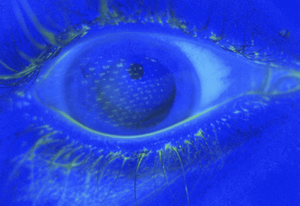Airbag injuries
Background
- Airbag deployment can cause injury via multiple mechanisms, such as:
- Caustic injuries from aerosolized alkali (including sodium hydroxide and sodium carbonate)
- Blunt trauma from direct contact with airbag
- Rapid deceleration and associated flexion and/or hyperextension injuries
Clinical Features
Burns
- Usually minor
- Related to direct contact with skin or heat from melted clothing
- Deployment releases small amount of alkali
- Skin burns are usually minor
- Ocular burns require irrigation, pH testing and ophtho follow up
- Long-term sequelae are rare
Ocular Injuries

Corneal Abrasions from Airbag Deployment

Corneal Abrasions from Airbag Deployment
- Chemical keratitis
- Corneal Abrasion
Cervical and Thoracic Spine Injuries
Myocardial rupture
- Uncommon complication
- Can exist with barotrauma alone with the absence of rib fractures[1]
Differential Diagnosis
Caustic Burns
- Caustic ingestion
- Caustic eye exposure (Caustic keratoconjunctivitis)
- Caustic dermal burn
- Airbag-related burns
- Hydrofluoric acid
- Tar burn
- Cement burn
Workup
- Depends on location/type of suspected injury
Management
Disposition
- Depends on type and severity of injury
References
- Lancaster GI, et al. Air-bag-associated rupture of the right atrium. N Engl J Med. 1993; 328:358.
- Brodovsky SC, et al: Management of alkali burns: An 11-year retrospective review. Ophthalmology. 2000; 107:1829-1835.
This article is issued from
Wikem.
The text is licensed under Creative
Commons - Attribution - Sharealike.
Additional terms may apply for the media files.